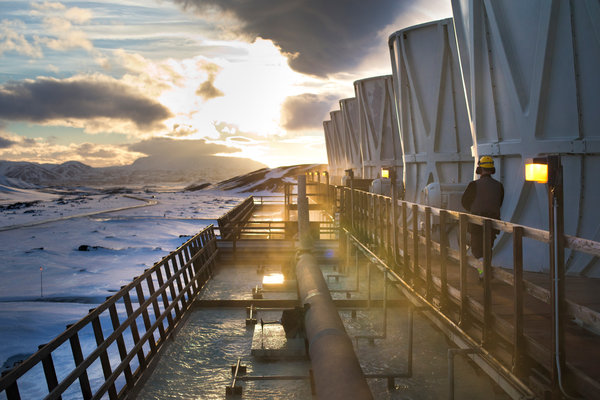
KRAFLA, Iceland — Soon after work began here on a power plant to harness some of the vast reserves of energy stored at the earth’s crust, the ground moved and, along a six-mile-long fissure, began belching red-hot lava. The eruptions continued for nine years, prompting the construction of a stone and soil barrier to make sure that molten rock did not incinerate Iceland’s first geothermal power station.
While the menacing lava flow has long since stopped and Krafla is today a showcase of Iceland’s peerless mastery of renewable energy sources, another problem that has dogged its energy calculations for decades still remains: what to do with all the electricity that the country — which literally bubbles with steam, hot mud and the occasional cloud of volcanic ash — is capable of producing.
In a nation with only 320,000 people, the state-owned power company, Landsvirkjun, which operates the Krafla facility, sells just 17 percent of its electricity to households and local industry. The rest goes mostly to aluminum smelters owned by the American giant Alcoa and other foreign companies that have been lured to this remote North Atlantic nation by its abundant supply of cheap energy.
Now a huge and potentially far more lucrative market beckons — if only Iceland can find a way to transmit electricity across the more than 1,000 miles of frigid sea that separate it from the 500 million consumers of the European Union. “Prices are so low in Iceland that it is normal that we should want to sell to Europe and get a better price,” said Stein Agust Steinsson, the manager of the Krafla plant. “It is not good to put all our eggs in one basket.”
What Landsvirkjun charges aluminum smelters exactly is a secret, but in 2011 it received on average less than $30 per megawatt/hour — less than half the going rate in the European Union and barely a quarter of what, according to the Renewable Energies Federation, a Brussels-based research unit, is the average tariff, once tax breaks and subsidies are factored in, for “renewable” electricity in the European Union. Iceland would not easily get this top “renewable” rate, which is not a market price, but it still stands to earn far more from its electricity than it does now.
Eager to reach these better paying customers, the power company has conducted extensive research into the possibility of a massive extension cord — or a “submarine interconnector,” in the jargon of the trade — to plug Iceland into Europe’s electricity grid. Such a cable would probably go first to the northern tip of Scotland, which, about 700 miles away, is relatively close, and then all the way to continental Europe, nearly 1,200 miles away. That is more than three times longer than a link between Norway and the Netherlands, which is currently the world’s longest.
Laying an underwater cable from the North Atlantic would probably cost more than $2 billion, and the idea is not popular with those who worry about Iceland — a country that takes pride in living by its own means in harsh isolation — becoming an ice-covered version of Middle East nations addicted to easy money from energy exports.
Backers of the cable “are looking for easy money, but who is going to pay in the end?” said Lara Hanna Einarsdottir, an Icelandic blogger who has written extensively on the potential risks involved in geothermal energy. “We will all pay.”
Iceland, Ms. Einarsdottir said, should use its energy sources to “supply ourselves and coming generations” and not gamble with Iceland’s unique heritage by “building more and more plants so that we can provide electricity to towns in Scotland.”
The idea of somehow exporting electricity to Europe has been around for decades and has been “technically doable for some time,” said Hordur Arnarson, the power company’s chief executive, “but it was not seen as economically feasible until recently.” The change is largely because of a push by the European Union to reduce the use of oil and coal and promote green energy, a move that has put a premium on electricity generated by wind, water and geothermal sources. The union’s 27 member states agreed in 2009 to a mandatory target of deriving at least 20 percent of its energy from “renewable sources” by 2020.
A connection to Europe would not only allow Iceland to tap the export market but also to import electricity from Europe in the event of a crisis, a backup that would allow it to stop keeping large emergency reserves, as it does now.
“This is a very promising project,” Mr. Arnarson said. “We have a lot of electricity for the very few people who live here.” Compared with the rest of the world, he said, Iceland produces “more energy per capita by far, and it is very natural to consider connecting ourselves to other markets.”
For example, in the region around the Krafla plant, where Landsvirkjun is due to build a second geothermal power station, there are just 400 residents. The only nearby business is a health complex with a big outdoor pool and saunas, but it does not use much electricity, as its hot water and heating all come from the ground. Most Icelandic homes and offices, once reliant on coal- and wood-fired furnaces, are now kept warm by geothermal energy.
Whether Iceland pursues the cable project depends on a government committee now reviewing the idea. “If there is not a broad consensus, we won’t do it,” Mr. Arnarson said.
But pressure to find new markets for its electricity is growing as the gap between plentiful supply and tepid local demand widens. Parliament in January approved a new energy “master plan” that gives a green light to at least 11 new geothermal power stations and two additional hydroelectric projects.


